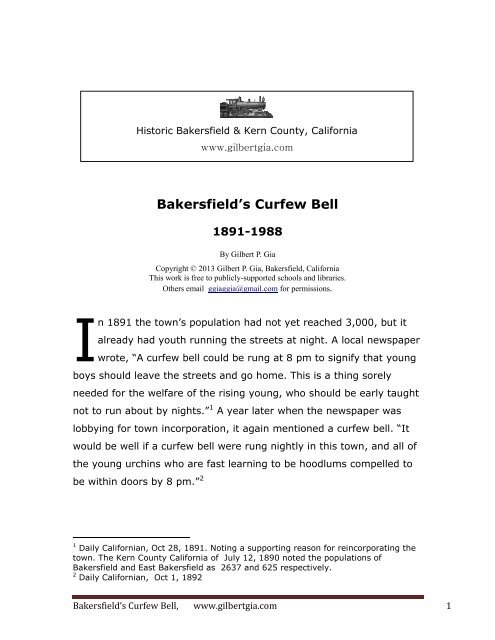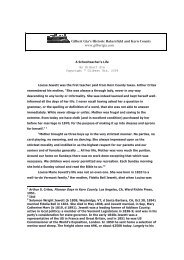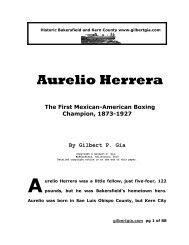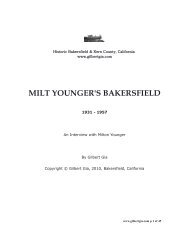Bakersfield's Curfew Bell, 1891-1988 - Gilbertgia.com
Bakersfield's Curfew Bell, 1891-1988 - Gilbertgia.com
Bakersfield's Curfew Bell, 1891-1988 - Gilbertgia.com
Create successful ePaper yourself
Turn your PDF publications into a flip-book with our unique Google optimized e-Paper software.
Historic Bakersfield & Kern County, California<br />
www.gilbertgia.<strong>com</strong><br />
Bakersfield’s <strong>Curfew</strong> <strong>Bell</strong><br />
<strong>1891</strong>-<strong>1988</strong><br />
By Gilbert P. Gia<br />
Copyright © 2013 Gilbert P. Gia, Bakersfield, California<br />
This work is free to publicly-supported schools and libraries.<br />
Others email ggiaggia@gmail.<strong>com</strong> for permissions.<br />
I<br />
n <strong>1891</strong> the town’s population had not yet reached 3,000, but it<br />
already had youth running the streets at night. A local newspaper<br />
wrote, “A curfew bell could be rung at 8 pm to signify that young<br />
boys should leave the streets and go home. This is a thing sorely<br />
needed for the welfare of the rising young, who should be early taught<br />
not to run about by nights.” 1 A year later when the newspaper was<br />
lobbying for town incorporation, it again mentioned a curfew bell. “It<br />
would be well if a curfew bell were rung nightly in this town, and all of<br />
the young urchins who are fast learning to be hoodlums <strong>com</strong>pelled to<br />
be within doors by 8 pm.” 2<br />
1 Daily Californian, Oct 28, <strong>1891</strong>. Noting a supporting reason for reincorporating the<br />
town. The Kern County California of July 12, 1890 noted the populations of<br />
Bakersfield and East Bakersfield as 2637 and 625 respectively.<br />
2 Daily Californian, Oct 1, 1892<br />
Bakersfield’s <strong>Curfew</strong> <strong>Bell</strong>, www.gilbertgia.<strong>com</strong> 1
East of Bakersfield at Kern City unsupervised juveniles were also<br />
problems. 3 The Daily Californian wrote in 1892,<br />
“Our little sister talks incorporation and means it, but it is well to<br />
note that the tendency of Kern city [sic] toward incorporation has<br />
been brought about by the efforts of aggressive and enterprising<br />
businessman: men of affairs who look forward to a still more<br />
successful future. We are not too old to learn from our neighbor,<br />
nor should be be so foolishly proud as not to follow her example. ...<br />
The evil that flaunts by day in certain quarters, for the good name<br />
and fair fame of this town, to say nothing of the unspoken demands<br />
of pure womanhood, should be made to duck its head and keep<br />
quiet. If a curfew bell could be rung, after which boys verging<br />
toward manhood would be <strong>com</strong>pelled to be and stay at home, not<br />
only the better for them and the hearts of their mothers, but far<br />
safer for some other’s daughters.” 4<br />
Neither Bakersfield nor Kern City established a curfew bell. A few<br />
months later the Californian wrote, “Visalia now rings a curfew bell at<br />
9 o’clock each evening at which four boys under 18 years of age are<br />
supposed to retire to their homes. Such an ordinance might be<br />
adopted in other towns with good results.” 5<br />
Most local newspapers supported moral reform, and those<br />
policies were perpetuated when they were sold. The case of Mr. Alfred<br />
Harrell is an example. In 1884 he was at Poso where he was the<br />
teacher at Shamrock School. When the school was about to close for<br />
summer, A.C. Maude, publisher and proprietor of the Kern County<br />
Californian, reported, “Mr. Harrell will leave this week for Tombstone,<br />
3 Kern City is now East Bakersfield<br />
4 Daily Californian, Nov 18, 1892. “The evil that flaunts by day” was the Tenderloin<br />
district. Kern City incorporated Dec 12, 1893, but Bakersfield did not until 1898.<br />
5 The Californian, May 20, 1893<br />
Bakersfield’s <strong>Curfew</strong> <strong>Bell</strong>, www.gilbertgia.<strong>com</strong> 2
Arizona, where he has a sister living. He will probably return in May.<br />
Although a young man, we believe Kern county [sic] can boast of no<br />
better teacher. He sets for his school the example of good morals and<br />
industry, and we predict for him success wherever he may go.” 6<br />
Young, energetic Alfred Harrell also served on the Kern County<br />
Board of Education. In 1886 the Democratic Party formally nominated<br />
him to the board of Kern County Superintendent of Schools, to which<br />
he was elected. 7 In 1889 Harrell got his first taste of the newspaper<br />
business when he was stand-in editor of the Kern County Gazette. In<br />
the late 1890s when Kern County High School principal E.F. Goodyear<br />
abruptly resigned to return to the classroom, the Board appointed its<br />
secretary, Alfred Harrell, as temporary high school principal. 8 In 1897,<br />
34 year-old Harrell bought the Daily Californian, and although he was<br />
no longer in the field of education, his support for it continued for the<br />
rest of his life. 9 Shortly after buying the newspaper he reprinted the<br />
following letter, which he lifted from from the Morning Echo.<br />
“Notise”<br />
“With the kind permishun of the Californian, I wish to call the<br />
attenshun of everybody to a grate injustus that is to be did to<br />
the boys of Bakersfield. It is a tereany to be known as the<br />
kerfew bel. When this bel wrings at 8 oclock every boy and girl<br />
6 Kern County Californian, Apr 4, 1885<br />
7 The Californian, Mar 5, 1895. Kern County Californian, Jun 13, 1885. Kern County<br />
Californian, Aug 28, 1886, “Bakersfield, Cal., Aug 22, 1886. One of the most<br />
interesting and enthusiastic Democratic County Conventions held in the found for<br />
many years was the order of the day yesterday. ... Alfred Harrell was the choice for<br />
School Superintendent.” Harrell served as County Superintendent of school and<br />
Secretary of the High School Board of Trustees from 1893 to 1899.<br />
8 One of Those Exceptions (Bakersfield Echo), Daily Californian, Oct 19, 1898. After<br />
Harrell became interim principal, Goodyear resigned from the district. In the adjacent<br />
column, D.W. Nelson refuted the Echo’s accusation that Harrell precipitated<br />
Goodyear’s resignation.<br />
9 Pioneer Journalist, Students’ Friend Dies, Bakersfield Californian, Dec 12, 1946<br />
Bakersfield’s <strong>Curfew</strong> <strong>Bell</strong>, www.gilbertgia.<strong>com</strong> 3
has to be in bed. Think of that. If any boy is ketched on the<br />
strete after the kerfew bel rings by Ed Willow they are to be<br />
taken to gail and there put in the deepest dungon sell and fed on<br />
bred and wator and torched til they confes. This law will never<br />
be passed with the consent of the boys of this city. It is<br />
oppreshun to which we will not submit. Think of the menny<br />
brave boys who are the support of unhealthy parents. We read<br />
of them every day in the paper. Suppose a boy who is the only<br />
support of a widowed family is nite whatchin in a bank where a<br />
cool and corageous guard is need against Robbers. Shall they<br />
seeze such a boy as he goes to his werk and confin him in a<br />
deundgon sell. Never! Never! Never! There is a way out. Boys<br />
shood vote! But vote or no vote we will not be oppressed by the<br />
minyuns of the law. Kerfew shell not ring to-nite nor to morrow<br />
nite neether! –- The Yellow Kid of Opera Alley (Hogan’s alley of<br />
Bakersfield.) [The foregoing is given verbatim et literatim et<br />
spellatim et punctuatim, just as received.]” 10<br />
10 Daily Californian, Jan 21, 1897. Leo G. Pauly graduated from San Jose State<br />
Normal School in Nov 1895, after which he became principal of the Tehachapi school.<br />
He continued in that position for two years. In 1897, when he was 22, he accepted<br />
the post of principal of the Kern City school. (Wallace Melvin Morgan, History of<br />
Kern County, California. Historic Record Co, Los Angeles, California, 1914, p 380)<br />
Bakersfield’s <strong>Curfew</strong> <strong>Bell</strong>, www.gilbertgia.<strong>com</strong> 4
Background to the letter: In 1897 Deputy City Marshal Ed I.<br />
Willow shot and killed Percy Douglass, a violent member of a<br />
respected Kern County family. 11 The Yellow Kid was a bald, snaggletoothed<br />
cartoon character in an oversized, yellow nightshirt who was a<br />
denizen of Hogan’s Alley. That fictitious setting represented New York<br />
City slums of the turn of the century. Opera alley was in the<br />
Bakersfield Tenderloin between L and M and 19th and 20th Streets. It<br />
was Bakersfield’s Hogan’s Alley. In 1896 William Randolph Hearst<br />
sponsored the Yellow-Fellow Transcontinental Bicycle Race to boost<br />
circulation of his New York Herald. In August the Daily Californian<br />
sponsored its Yellow Tandem bicycle race. 12<br />
Kern City trustees wrote a curfew ordinance sometime prior to<br />
1892. Police did not regularly enforce it, but in 1892 they did.<br />
“Principal Pauly announced in the schools today that the curfew<br />
ordinance would be strictly enforced hereafter and warned the<br />
children not to appear on the streets after the ringing of the curfew<br />
without a note from their parents. A number of the young boys<br />
have made a custom to hang around town until late at night and as<br />
a consequence would not be able to do their schoolwork the next<br />
day, and upon <strong>com</strong>plaint of the school authorities to the trustees at<br />
their meeting last night it was decided to rigidly enforce the<br />
ordinance. The engineer at the firehouse was instructed to ring the<br />
bell eight times at eight o'clock every evening, and after that time<br />
no minors are to be allowed on the streets. Marshall Badger and<br />
11 Episodes from the life of Ed Willow appear in Chief Willow and the Roses Thief by<br />
Gilbert P. Gia at www.gilbertgia.<strong>com</strong>.<br />
12 See Bicycling California in 1896 by Gilbert P. Gia at www.gilbertgia.<strong>com</strong><br />
Bakersfield’s <strong>Curfew</strong> <strong>Bell</strong>, www.gilbertgia.<strong>com</strong> 5
night watchman Selna will do all in their power to see that the<br />
ordinance is enforced." 13<br />
In 1898 Bakersfield reincorporated on a vote of 387 to 146, 14<br />
but a curfew ordinance had to wait until 1903 when offices of the new<br />
government were established and working. An article in Harrell’s Daily<br />
Californian in July 1903, entitled City Marshal Will Arrange to Have the<br />
<strong>Bell</strong> Rung Every Night, read as follows:<br />
“The W.C.T.U. members have called attention to the fact that the<br />
curfew has not been rung for several days as required by the city<br />
ordinance. City marshal Tibbets [sic, Tibbetts] said today that he<br />
will take steps at once to see that the ordinance is enforced, but the<br />
ringing of the bell has been done as a courtesy by the fire<br />
department, and there is no one at present regularly assigned to do<br />
the work. Some arrangement will probably have to be made in this<br />
direction. The marshal and all city officers strongly approve of the<br />
ordinance and its strict enforcement." 15<br />
East of Bakersfield at Kern City in 1903, the town council (and<br />
the Daily Californian), seem to have forgotten that Kern City wrote a<br />
curfew ordinance ten years earlier. In A <strong>Curfew</strong> Law Is Proposed In<br />
Kern, the Californian wrote, “The ringing of the bell every evening of 8<br />
o’clock will warn all children off the streets and might result in much<br />
good, as has been found to be the case in other places. The bell could<br />
also be very useful for fire alarm purposes.” 16<br />
13 Bakersfield Californian, Nov. 18, 1892. Leo G. Pauly was then supervising principal<br />
of Kern City schools.<br />
14 History of Kern County. Morgan, 1914, p 123. Bakersfield incorporated Jan 4,<br />
1898.<br />
15 Daily Californian, Jul 16, 1903. Women’s Christian Temperance Association<br />
16 Daily Californian, Aug 6, 1903<br />
Bakersfield’s <strong>Curfew</strong> <strong>Bell</strong>, www.gilbertgia.<strong>com</strong> 6
Although a curfew had been proposed, three years passed before<br />
it was enacted. The Californian reported, “Ordinance No. 5, related to<br />
the curfew bell, was read and will be rigidly enforced by the officials.<br />
The curfew will be rung from the engine house bell and will consist of<br />
nine distinct taps. Three of these will be sounded, then a pause, and<br />
three more. 17<br />
A reading of the ordinance suggests perils issuing from the adult<br />
entertainments along Baker Street and from the nearby Southern<br />
Pacific tracks.<br />
“Section 1. It shall be unlawful and it is hereby declared a nuisance<br />
for any minor child, under the age of 18 years, to visit or loiter<br />
about any gambling house, bar, saloon or any place were<br />
spirituous, malt or vinous liquors are are sold or dispensed or about<br />
any house of prostitution.” 18<br />
“Section 2. It shall be unlawful and it is hereby declared a<br />
nuisance for any child under the age of 18 years, to play or loiter<br />
about any railroad depot, or the cars of any railroad of this town, or<br />
to ride upon any railroad car, engine, truck or other vehicle, without<br />
the consent of the agent or owner thereof.” 19<br />
“Sec 3. It shall be a misdemeanor for any minor child under the<br />
age of 18 years, to be in any street or public place within the<br />
corporate limits of the town of Kern, except a lawful exhibition party<br />
or entertainment, between the hours of 8 p.m. and 5 a.m. of the<br />
following day from the first day of November to the first day of April<br />
following, and of 9 o’clock p.m. and 5 o’clock am of the following<br />
day from the first day of April to the first day of November<br />
17 Daily Californian, Jul 17, 1906<br />
18 Ibid.<br />
19 Ibid.<br />
Bakersfield’s <strong>Curfew</strong> <strong>Bell</strong>, www.gilbertgia.<strong>com</strong> 7
following, unless ac<strong>com</strong>panied by a parent or guardian of such<br />
minor, or unless having a written permit from such parent or<br />
guardian to be on a lawful errand. 20<br />
“Any minor violating this ordinance may be arrested, taken<br />
charge of and detained by the town marshal until daylight after his<br />
arrest, and the expense of arresting taking car of him and returning<br />
him to his home shall be charged against the parent, guardian or<br />
other persons having charge of such minor, and shall be recovered<br />
by civil action, if not paid on demand.” 21<br />
The curfew bell at Bakersfield again fell into disuse, but by 1908<br />
juvenile delinquency had increased alarmingly. The following appeared<br />
in Harrell’s Bakersfield Californian under the heading Will Enforce<br />
<strong>Curfew</strong> Law.<br />
“A small boy nuisance at night time, which has resulted in<br />
numerous false alarms for the fire department, short-circuits for the<br />
electric light <strong>com</strong>pany and other annoyances, will probably be<br />
solved by a rigid enforcement of the curfew ordinance which has<br />
been on the city law books for some years, though remaining much<br />
of a dead letter up to this time. “ 22<br />
“By its terms it is unlawful for children of 16 or under to be upon<br />
the streets after eight o'clock at night. Trustee McDonald is making<br />
the agitation for the enforcement of this provision of the city<br />
statutes, and will take the matter up with the local officers. Now<br />
that the Superior Court has established probation <strong>com</strong>mittee to deal<br />
with juvenile offenders it will probably be much easier to take up<br />
such cases. At any rate, it is believed that the arrest of a few<br />
20 Ibid.<br />
21 Daily Californian, Jul 17, 1906<br />
22 Bakersfield Californian, Nov 19, 1908<br />
Bakersfield’s <strong>Curfew</strong> <strong>Bell</strong>, www.gilbertgia.<strong>com</strong> 8
youthful ‘rounders’ will have the desired authority effect upon the<br />
others, and the intention is to make an example of the first boys<br />
who fall into the dragnet of the police. In Pasadena, where the<br />
curfew law is very strictly enforced, the bell of each schoolhouse is<br />
given a single tap by the policeman on beat in each residence<br />
district, promptly on the stroke of eight. Woe follows the youngster<br />
who is caught up on the street after this hour. While this plan can<br />
hardly be operated here, because of the scarcity of officers, it is<br />
intended that the enforcement of the law shall be equally sure." 23<br />
Six months later the promised arrest of a few youthful rounders<br />
had done little good to stem delinquency. District Attorney Laird was<br />
livid when yet again confronted with the spectacle of “urchins” charged<br />
with burglarizing stores. "Enforce the city's curfew law, and Bakersfield<br />
will have less youthful criminals and reckless children," he insisted. In<br />
the same newspaper interview of June 19, 1909 he warned,<br />
"There is no need of rearing criminals among our children. If the<br />
curfew law is enforced, a big majority of the children under 18<br />
years of age will be at home or going home when the bell rings at 8<br />
PM. I remember when they used to enforce the law in the city<br />
(partially), more so than they do now, and when the curfew<br />
sounded the kids hiked for home. If the parents will not keep them<br />
in the night, it is up to the officers to see that boys and girls 10 to<br />
12 years of age are at home, at least off the down-town streets.<br />
That's the way children get the wrong idea of life. Sometimes<br />
parents are to blame, but they will in most cases co-operate with<br />
the officers if the latter intends to enforce the city statutes. 24<br />
23 Bakersfield Californian, Nov 19, 1908<br />
24 Morning Echo, June 19, 1909<br />
Bakersfield’s <strong>Curfew</strong> <strong>Bell</strong>, www.gilbertgia.<strong>com</strong> 9
When he asked what should be done with those youth that<br />
Constable Newell arrested for burglary, the reply was, “It is not right<br />
to send them to prison or to a reform school, yet we have to do<br />
something with them. They can't be allowed to go on in this way." 25<br />
Laird replied,<br />
"Do you know that three-fourths of our criminals and dead women<br />
start wrong from lack of proper parental care and indifference on<br />
the part of the officers to keep them off the streets? Some children<br />
are degenerates with whom very little can be done, but a big<br />
majority are not and can be made useful citizens if the proper<br />
actions can be exercised with them when young. I don't know what<br />
I shall try to have done with these boys, but I do know that their<br />
chances for crime and evil pursuits would be greatly lessened if the<br />
curfew ordinance were enforced." 26<br />
He accused city trustees of dereliction of duty; it was up to them<br />
to see that the laws were upheld. Laird added,<br />
"If the laws are not enforced, it is for them to find out why, and if<br />
the man or parties who have that power do not enforce the law it is<br />
high time they were brought to task for their inattention to duty.<br />
Officers are sworn to enforce the law and preserve order. What do<br />
they do in Bakersfield? Out of all the books full of ordinances the<br />
only one they make a pretense of enforcing is the auto taillight<br />
ordinance. One of the most insignificant in the lot. It is high time a<br />
part of our good ordinances, especially those about children, were<br />
enforced." 27<br />
25 Morning Echo, June 19, 1909<br />
26 Morning Echo, June 19, 1909. “Dead women” (prostitutes)<br />
27 Morning Echo, June 19, 1909<br />
Bakersfield’s <strong>Curfew</strong> <strong>Bell</strong>, www.gilbertgia.<strong>com</strong> 10
The DA’s storming might have been why the council paid Ed<br />
Willow $5 a month to ring the 8 pm curfew bell. 28 Laird’s diatribe<br />
might also have produced other changes, too, but the curfew<br />
nevertheless lapsed, and five months later the Women’s Civic<br />
Improvement League was seeking re-enforcement the curfew<br />
ordinance. 29<br />
Wording of the ordinance resulted in a disconnect between<br />
Mother Nature and intent of the curfew. In 1913 Wallace Morgan<br />
pointed out that the hour of 8:00 pm was too early in summer for the<br />
bell to be rung and would “deprive children of the privileges of the<br />
streets.” 30<br />
By 1914 Bakersfield’s population was estimated at 15,538, which<br />
made it the 15th-largest city in California. 31 Population here had<br />
outstripped police resources, although some smaller towns continued<br />
to ring a curfew bell. In 1914 Taft city trustees told Marshal Ed Eiland<br />
to enforce the town’s curfew ordinance, which established the hour for<br />
children under 16 at 8:30 pm, at least until the month of April when<br />
they were allowed to remain on the streets until 9:00. The town’s fire<br />
alarm bell announced the curfew, “nine taps indicating the retiring<br />
hour.” 32<br />
Nearby Maricopa also had a curfew, but that one was seldom<br />
unenforced if at all. In 1915 Maricopa police, and the municipal justice,<br />
were apparently indifferent to young people running the streets at<br />
28 Morning Echo, Oct 8, 1911<br />
29 Bakersfield Californian, Dec 1, 1911. Superintendent of Bakersfield schools DW<br />
Nelson reported that student enrollment was 1,742. (Bakersfield Californian, Sep 19,<br />
1910)<br />
30 Bakersfield Californian, Sep 19, 1913<br />
31 Morning Echo, May 10,1914<br />
32 Bakersfield Californian, Mar 4, 1914<br />
Bakersfield’s <strong>Curfew</strong> <strong>Bell</strong>, www.gilbertgia.<strong>com</strong> 11
night and to public drunkenness and open prostitution, as suggested in<br />
this letter to the Bakersfield Morning Echo. A Maricopa mother wrote,<br />
“A short time ago a number of our young boys were on the street<br />
at night and were arrested for disturbing the peace. The justice<br />
turned them loose and laughed and said they were not bad boys, as<br />
they hadn’t killed anyone yet. And one of the boys’ mother has<br />
pleaded with the boy and with an officer to take him in charge. 33<br />
Who is to blame—the parents or the officers? We have asked for a<br />
curfew bell. Oh, yes, we could have it; no reason in the world why<br />
we couldn’t. I think it was rung a dozen times and [with] no one to<br />
enforce the law. Are the parents wholly to blame?” 34<br />
Bakersfield’s Board of Trustees voted in 1915 to stop ringing a<br />
curfew bell but otherwise preserve the ordinance and keep it “entirely<br />
effective as before, and all minors are called upon to observe it or<br />
meet up with reproof from the night officers.” 35 It made it a<br />
misdemeanor for parents to allow their children under 16 to be on the<br />
streets after 9:00 pm, and the ordinance provided a fine or jail<br />
sentence for violation. 36<br />
Nine months after that, City Manager Benson stood before the<br />
city council and attested that the curfew ordinance had been ignored<br />
or forgotten by the police. The council turned to Chief of Police E.<br />
Porter Munsey and instructed him that the ordinance was a “live<br />
ordinance” and he was expected to enforce it. 37 The effect was<br />
probably immediate because the Kern County Grand Jury report of<br />
33 Arrest him<br />
34 Morning Echo, Feb 2, 1915<br />
35 Bakersfield Californian, Nov 17, 1915<br />
36 Bakersfield Californian, Aug 14, 1917. “Unless ac<strong>com</strong>panied by their parents or<br />
guardians, or on errands or engaged in some work which calls them out on the<br />
streets after that hour.”<br />
37 Bakersfield Californian, Aug 14, 1917<br />
Bakersfield’s <strong>Curfew</strong> <strong>Bell</strong>, www.gilbertgia.<strong>com</strong> 12
1918 approved of the chief’s curfew-enforcement policy, although it<br />
also urged the chief to stringently enforce the law against minors<br />
driving cars. 38<br />
Historically, the curfew law of 1914, Ordnance No. 264, was<br />
seldom enforced. In 1940 Bakersfield police justified their selective use<br />
of it when they pointing out that the department kept “wayward<br />
Bakersfield ‘bad boys’ under perpetual surveillance to reduce juvenile<br />
delinquency.” 39 In late 1942 the curfew was dusted off again in<br />
support of warnings to juveniles who were looking forward to a lively<br />
Halloween: “DON’T ring doorbells, you may disturb a war worker.<br />
DON’T use tick-tocks on windows, war workers need their sleep.” 40<br />
<strong>Curfew</strong> enforcement reemerged in 1957 with an upswing in<br />
residential burglaries, half of which were <strong>com</strong>mitted by juveniles. 41<br />
Ordnance No. 264 was once again Bakersfield’s Elastic Clause. 42<br />
< O ><br />
38 Morning Echo, Nov 13, 1919<br />
39 Bakersfield Californian, Jul 17, 1940<br />
40 Halloween, City Invokes <strong>Curfew</strong> Law for Juveniles. If You’re Under 21, Don’t Roam<br />
Streets After 9 P.M. Tonight or Saturday, Bakersfield Californian, Oct 30, 1942.<br />
41 Bakersfield Californian, Dec 31, 1957<br />
42 On Nov 30, <strong>1988</strong> the Bakersfield City Council passed Municipal Ordinance No.<br />
3188, which established a curfew from 10 pm to 5 am “for persons under the age of<br />
18 years.”<br />
Bakersfield’s <strong>Curfew</strong> <strong>Bell</strong>, www.gilbertgia.<strong>com</strong> 13












